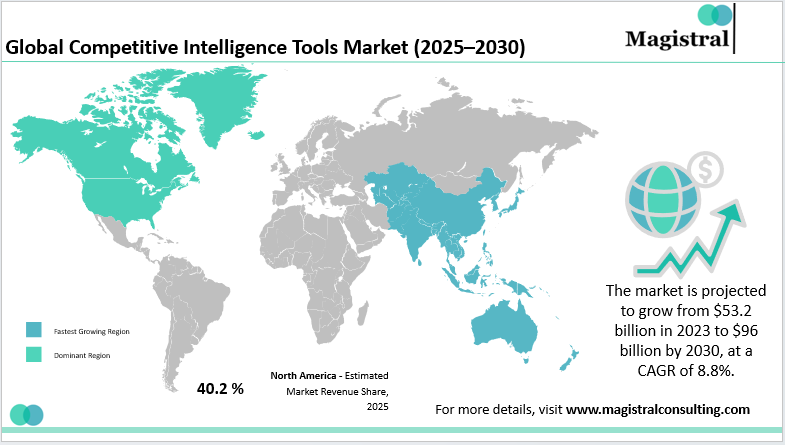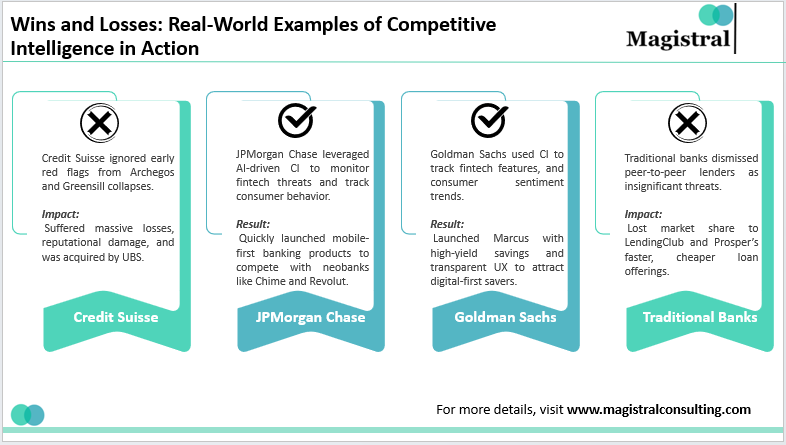With fast-changing technology and vibrant market fluctuations, competitive intelligence has become an important building block for companies wanting to be ahead of competition. CI collected and organized evidence concerning the rivals, their markets, and buying patterns so that the company can make informed decisions on when to strike or when to prepare for disruptions as they see growth opportunities. This article discusses the transformation seen in 2025 with respect to trends and strategies that are going to change the future of business intelligence.
The Expanding Landscape of Competitive Intelligence
The trend of rapid development of competitive intelligence tools has taken a global twist, with the market valuation rising to $53.2 billion in 2023 projections that could reach $96 billion by 2030, translating to a compound annual growth rate (CAGR) of 8.8 percent. This growth is driven by increasing businesses” need to cope up with the multiple complexities of the market, understand the preferences of consumers, and react quickly to the competitive threats.
The move towards cloud-based CI solutions that could deliver scalability, real-time access to data, and cost efficiencies is another trend supporting the growth. Cloud deployment segment is forecast to reach $54.5 billion by 2030, growing with a CAGR of 9.5%. Organizations may thus be able to easily plug these CI tools into their existing digital infrastructure and have more agile and responsive decision-making processes.

Global Competitive Intelligence Tools Market (2025–2030)
Regional Adoption and Market Dynamics
Regional acceptance of competitive intelligence tools varies, influenced by factors such as technological infrastructure, legal requirements, and market maturity.
North America
The region is the forerunner in the market and has the biggest market share, this is largely due to the early adoption of the latest technologies and a solid tendency towards data-driven decision-making.
Asia-Pacific
This region showed up overnight and now is the fastest-growing region, and the boom will be unstoppable since e-commerce has been flourishing rapidly because of digitization, the increase in CI solutions investment, and the makeup of the e-commerce sector.
Europe
At a time of stable expansion, the businesses have realized the need for CI to enter strategic planning and the competitive positioning as sectors, and, as a result, the CI has become the success factor.
The variations seen in these regions showcase how significantly the competitive intelligence domain has changed globally over the years as it has forced the business world to tailor new strategies to different markets apart from the local ones.
Strategic Insights and Best Practices for Competitive Intelligence
The best practices that help in the development and execution of CI initiatives in organizations that want optimal impact from competitive intelligence are:
Strategic and Actionable Intelligence
Instead of collecting raw data, organizations should be concerned about collecting intelligence in support of strategic decision-making. CI teams need to be trained to sift actionable insights from irrelevant ones. In a way, keeping a barometer to judge whether a piece of data’s importance is useful or not in making decisions.
Such intelligence will thus shift away from a large bias towards pure quantitative information- pricing or product features- towards richer qualitative insights, such as drivers behind competitor behaviour, their strategic objectives, and cultural or other transformations.
Multidisciplinary Collaboration and Cross-Functional Involvement
CI should not be isolated within one department of the organization. The culture of collaboration ensures that intelligence becomes a common means of enabling all departments, whereby everyone is in sync with the strategic goals of the organization.
Constant Monitoring and Adaptation
Competitive intelligence cannot be considered a one-time program but should be treated as a continuous process. This would mean establishing a real-time monitoring system of alerts on any change in the competitive arena, such as changing price parameters in the market, or entering into a strategic partnership.
When organizations maintain such agility and adaptiveness, they may still be able to anticipate threats well before their competitors come into existence and alter their strategy accordingly.
Use Predictive Analytics
AI and ML-powered predictive analytics will let organizations gauge future trends and possibly the strategic moves their competitors might adopt. Essentially, predictive tools use the stock of past information to ascertain patterns and yield foresight into where the market is heading and how this would affect competitors’ actions considering changing conditions.
Case Studies: Competitive Intelligence Wins (and Failures)
Competitive intelligence can significantly influence a competitive environment. Here’s how major players have used CI to win and others that had to pay the price of ignoring it.
Win: JPMorgan Chase- Using AI-Driven CI to Outpace Fintech Rivals
JPMorgan Chase has invested heavily in AI and data analytics to keep track of fintech innovation. Through its COiN (Contract Intelligence) platform, the bank uses machine learning to scan through legal documents, part ways through market signals. More importantly, however, it monitors competitor launches, feature sets, and regulatory filings.
When Chime and Revolut began garnering attention for their mobile-first banking, no-fee model services, JPMorgan considered it necessary to respond quickly. Using its CI, it identified customer feature preferences-instant payments, budgeting tools, and convenient mobile access-and launched Chase Secure Banking and Finn by Chase.
Lesson: Continuous AI-enabled CIs help traditional banks to move like fintechs-and stay relevant.
Fail: Credit Suisse- Missed Signals Conditional to Risk Intelligence
The collapse of Credit Suisse in 2023 was a perfect case of poorly aligned risk-related competitive intelligence. In contrast, Credit Suisse received no reaction to any sign from the meltdown of Archegos Capital Management and the collapse of Greensill Capital, while all its rivals’ reduced exposure and tightened internal controls on risk.
Their CI operations did not properly evaluate counterparties, missed much of marketplace chatter and some early news warnings, and generally missed the trend of a regulatory crackdown on opaque financial instruments.
Lesson: In finance, competitive intelligence must go together with risk intelligence-especially in a hyper-regulated, reputation-sensitive market.
Fail: Traditional Banks into Peer-to-Peer Lending Gap
Throughout most of the 2010s, traditional banks generally shunned the rise of peer-to-peer lending platforms such as LendingClub and Prosper. These online lenders provided better interest rates and more rapid processing to borrowers through their automated credit scoring and digital underwriting, coupled with leaner operating structures.
Most times that traditional players did respond, P2P lending had already stolen a slice of the market pie-it proved to be especially popular among younger borrowers and small businesses. Some banks eventually did partner with or outright acquire fintechs, but that cost them years of innovation and customer trust.
Lesson: Maverick disruptors can often give rise to blind spots. CI must track small entrants, not just large incumbents.
Win: Goldman Sachs-Utilizing CI as Aimed at Consumer Banking with Marcus
Goldman Sachs has used competitive intelligence-from its strictly institutional-focused operations-to penetrate that retail space with Marcus. By tracking consumer sentiment, fintech feature sets, and evolving savings habits, Goldman built Marcus to attract the digital-first saver.

Wins and Losses: Real-World Examples of Competitive Intelligence in Action
Conclusion
In 2025, Competitive Intelligence is a strategic core function now; it does not serve as a luxury or reactive measure anymore. As the market becomes more fragmented, digitized, and innovation-driven, it is a radar system that stimulates organizations to detect early threats, decodes how competitors behave, and snatches opportunities that arise. Real-time, cloud-based, and predictive CI tool users will position themselves best to adapt to change and act precisely. From JPMorgan’s agile fintech to the cautionary tales of Credit Suisse and traditional banks, one thing is clear: the CI can make the difference between staying ahead and falling behind. By 2030, firms that focus on intelligence, collaboration, and foresight will largely define future competitive leadership as the global Competitive Intelligence market surges to about $96 billion.
About Magistral Consulting
Magistral Consulting has helped multiple funds and companies in outsourcing operations activities. It has service offerings for Private Equity, Venture Capital, Family Offices, Investment Banks, Asset Managers, Hedge Funds, Financial Consultants, Real Estate, REITs, RE funds, Corporates, and Portfolio companies. Its functional expertise is around Deal origination, Deal Execution, Due Diligence, Financial Modelling, Portfolio Management, and Equity Research
For setting up an appointment with a Magistral representative visit www.magistralconsulting.com/contact
About the Author
The article is authored by the Marketing Department of Magistral Consulting. For any business inquiries, you can reach out to prabhash.choudhary@magistralconsulting.com
Why are cloud-based solutions gaining traction in this space?
Cloud platforms offer flexibility, scalability, and real-time data access. They allow businesses to plug into intelligence systems with minimal setup, helping them respond faster to market changes.
Which regions are leading the shift towards advanced business intelligence?
North America is ahead thanks to early tech adoption. Asia-Pacific is growing rapidly due to digital transformation and e-commerce expansion. Europe is steadily embracing these tools for long-term strategic gains.
What makes competitive intelligence truly effective?
The most impactful approaches focus on actionable insights—not just data. Cross-functional collaboration, ongoing monitoring, and the use of predictive analytics are key to making these tools work across departments.
Can you share real examples of companies succeeding or struggling with intelligence efforts?
Yes. JPMorgan Chase used competitive intelligence powered by AI to react swiftly to fintech disruptions. Meanwhile, Credit Suisse missed crucial risk signals. Goldman Sachs, on the other hand, used market insight to successfully launch Marcus.